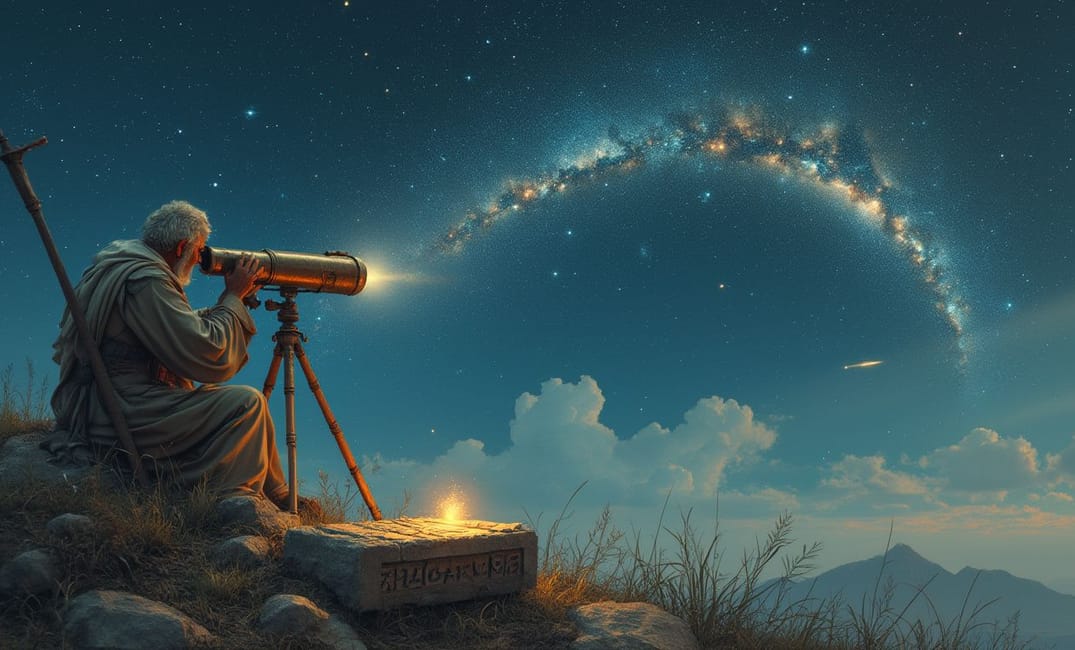Introduction: Humanity's Eternal Gaze at the Stars
Throughout history, humanity has been captivated by the night sky—a celestial tapestry of stars, planets, and mysteries. This awe-inspiring expanse above has stirred wonder and imagination, guiding civilizations to seek deeper understanding of the cosmos and their place within it. From ancient mythologies to modern space exploration, the human pursuit of knowledge and connection with the universe reflects an enduring aspiration for transcendence and discovery. This entry explores how perceptions and experiences of the cosmos have shaped human thought, belief, and innovation across epochs.
Ancient Celestial Observations: Foundations of Cosmic Insight
Mythology and the Celestial Sphere
- Mythological Interpretations: Across cultures, ancient peoples crafted myths and legends to explain celestial phenomena. The Greeks envisioned gods and heroes in the constellations, while the Egyptians saw the sky as a canopy for their sun god, Ra. These stories infused the night sky with meaning and served as moral, philosophical, and seasonal guides.
- Animal and Anthropomorphic Symbols: Many cultures used animals and human figures to represent celestial bodies. The Chinese saw the "Azure Dragon" in the constellations, while Native American legends wove tales around the "Great Bear" or "Big Dipper".
Early Astronomical Practices
- Calendrical Systems and Agriculture: Ancient civilizations, such as the Babylonians and Maya, relied on astronomical observations for calendrical accuracy, to time agricultural activities, and for ritualistic purposes. These practices laid the groundwork for astronomy as a discipline.
- Monuments Aligned with the Sky: Architectural wonders like Stonehenge in England and the Pyramids of Giza reflect human endeavors to align earthly structures with celestial cycles, offering insights into the astronomical knowledge and spiritual aspirations of ancient societies.
Scientific Revolution: Unveiling the Celestial Mechanics
From Geocentric to Heliocentric Models
- Ptolemy and Geocentrism: The Ptolemaic model, dominant until the Renaissance, positioned Earth at the universe's center. It reflected the prevailing philosophical and theological beliefs about humanity's central place in the divine cosmic order.
- Copernican Revolution: Nicolaus Copernicus's heliocentric model, proposing that the Sun was central, marked a profound paradigm shift. It challenged traditional views and laid the foundation for modern astronomy, altering humanity's self-perception in the cosmos.
Breakthroughs in Observational Astronomy
- Galileo and the Telescope: Galileo Galilei, with his telescopic observations of celestial bodies like Jupiter’s moons, provided empirical support for the heliocentric model. His discoveries challenged religious authorities and expanded scientific inquiry into the universe's vast intricacies.
- Kepler's Laws of Motion: Johannes Kepler's laws describing planetary motion further revolutionized scientific understanding of celestial mechanics, emphasizing the mathematical precision underlying cosmic phenomena.
The Age of Exploration: Charting the Celestial Frontier
Space Exploration Milestones
- Sputnik and the Space Race: The Soviet Union's launch of Sputnik in 1957 inaugurated the Space Age, triggering global interest in space exploration. The competition, primarily between the US and USSR, pushed technological boundaries, leading to unprecedented achievements.
- Apollo Moon Landings: The Apollo missions, particularly Apollo 11’s manned moon landing in 1969, symbolized human ingenuity and the spirit of exploration. Neil Armstrong's iconic statement, "That's one small step for man, one giant leap for mankind," resonated globally, epitomizing human potential.
The Expanding Horizon: New Frontiers
- Robotic Probes and Discoveries: Advancements have extended explorations beyond the Moon, with probes like Voyager, Mars Rovers, and the New Horizons mission, providing unparalleled insights into the solar system, interstellar space, and beyond.
- International Collaborations: Projects such as the International Space Station (ISS) exemplify successful international collaboration, promoting research across disciplines including biology, physics, and Earth science, fostering peaceful uses of outer space.
Cosmic Influence on Human Culture and Imagination
Artistic and Literary Inspirations
- The Cosmos in Art and Literature: Inspired by the universe, artists and writers have long explored the cosmos in their creations. Works ranging from Vincent van Gogh's "Starry Night" to literary masterpieces like Dante's "Divine Comedy" encapsulate the human quest to comprehend the celestial realm.
- Science Fiction and Speculative Realms: The genre of science fiction, pioneered by authors like Jules Verne and Isaac Asimov, has used space narratives to explore futuristic possibilities, societal reflections, and ethical questions, uplifting imagination and shaping public perception of space exploration.
The Cosmos in Music and Philosophy
- Celestial Melodies: Composers like Gustav Holst, with his suite "The Planets," translated celestial wonder into symphonic expressions, inviting audiences to transcend earthly confines and connect with the astral.
- Philosophical Contemplations: Philosophies from different cultures have pondered the cosmos’ nature, inspiring existential inquiry and contemplation about humanity’s place within this vast expanse. The cosmic theme often challenges humanity to consider the universe with humility and reverence.
Continued Exploration and the Quest for Understanding
Modern Astrophysics and Cosmology
- The Big Bang and Cosmic Evolution: The Big Bang theory has become foundational in understanding the universe's origin and evolution. Study of cosmic microwave background radiation and dark matter/energy continues to unveil mysteries, propelling physicists in the quest for a unified cosmic theory.
- Exoplanets and Potential Life: Discovering exoplanets within habitable zones opens dialogue on the potential existence of life beyond Earth, stimulating interdisciplinary research in astrobiology and planetary sciences.
Ethical and Existential Questions
- Space Colonization Aspirations: Discussions on space colonization elicit ethical and technical considerations; while offering solutions to Earth’s resource limitations, they also challenge humanity to consider ecological responsibility within other-worldly spheres.
- Shared Cosmic Heritage: Viewing Earth from space has broadened the perception of a shared humanity, prompting reflections on planetary stewardship, environmental sustainability, and unity as intrinsic cosmic citizens.
The Future of Human Exploration: Infinity Beckons
The Next Frontier: Mars and Beyond
- Future Missions and Technologies: Manned missions to Mars, advancements in propulsion technologies, and potential asteroid mining herald an era poised for deeper cosmic integration, with the potential to redefine humanity’s footprint in space.
- Interstellar Dreams and Possibilities: Initiatives like Breakthrough Starshot project humanity’s ambition toward interstellar travel, aiming to explore neighboring star systems and potentially unlock new dimensions of cosmic knowledge.
A Cosmic Perspective on Human Unity
- Empathy and Global Responsibility: Remembering the "Overview Effect" experienced by astronauts—a profound cognitive shift in perspective—encourages humanity to adopt a broader sense of kinship, nurturing empathy, cooperation, and a commitment to sustainable futures.
- Cosmic Stories and Collective Memory: Preserving the narrative of cosmic exploration invites future generations to imagine and aspire, securing the continuity of our celestial journey and participation in the universe's unfolding story.
Conclusion: An Unending Skyward Journey
The cosmos, with its infinite expanse and enigma, continues to inspire, challenge, and unite humanity in its quest for knowledge and connection. As humans look towards the stars, they see not only the mysteries of the universe but their reflection—a species driven by curiosity, creativity, and a relentless desire to explore. By forging paths in this cosmic journey, humanity embarks on an evolving narrative that stretches the boundaries of possibility, affirming its place within and responsibility to a larger universal tapestry—an eternal gaze that beckons with every twinkle and shadow.
"From ancient myths to modern voyages beyond Earth, humanity's journey among the stars is a testament to our intrinsic desire to explore the cosmos, weaving dreams with discovery and merging hopes with the boundless sky above."
HISTORY, MYTHOLOGY, IMAGINATION, COSMOS, ASTRONOMY, SPACE EXPLORATION

